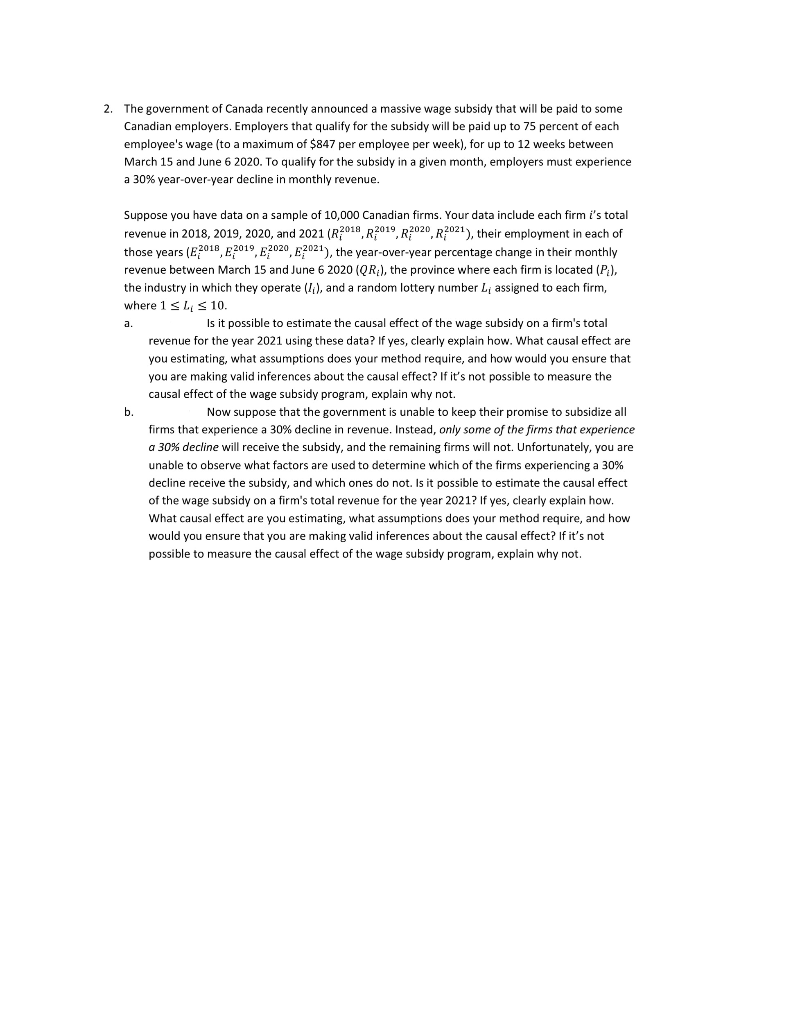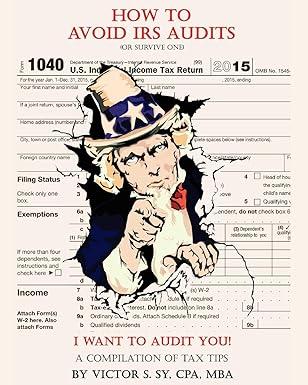
2. The government of Canada recently announced a massive wage subsidy that will be paid to some Canadian employers. Employers that qualify for the subsidy will be paid up to 75 percent of each employee's wage (to a maximum of $847 per employee per week), for up to 12 weeks between March 15 and June 6 2020. To qualify for the subsidy in a given month, employers must experience a 30% year-over-year decline in monthly revenue. Suppose you have data on a sample of 10,000 Canadian firms. Your data include each firm i's total revenue in 2018, 2019, 2020, and 2021 (R2018, 2019, R2020, R2021), their employment in each of those years (E2014, 2015, 2020, E202), the year-over-year percentage change in their monthly revenue between March 15 and June 6 2020 (QR:), the province where each firm is located (P), the industry in which they operate (11), and a random lottery number L assigned to each firm, where 1 SL $10. Is it possible to estimate the causal effect of the wage subsidy on a firm's total revenue for the year 2021 using these data? If yes, clearly explain how. What causal effect are you estimating, what assumptions does your method require, and how would you ensure that you are making valid inferences about the causal effect? If it's not possible to measure the causal effect of the wage subsidy program, explain why not. Now suppose that the government is unable to keep their promise to subsidize all firms that experience a 30% decline in revenue. Instead, only some of the firms that experience a 30% decline will receive the subsidy, and the remaining firms will not. Unfortunately, you are unable to observe what factors are used to determine which of the firms experiencing a 30% decline receive the subsidy, and which ones do not. Is it possible to estimate the causal effect of the wage subsidy on a firm's total revenue for the year 2021? If yes, clearly explain how. What causal effect are you estimating, what assumptions does your method require, and how would you ensure that you are making valid inferences about the causal effect? If it's not possible to measure the causal effect of the wage subsidy program, explain why not. 2. The government of Canada recently announced a massive wage subsidy that will be paid to some Canadian employers. Employers that qualify for the subsidy will be paid up to 75 percent of each employee's wage (to a maximum of $847 per employee per week), for up to 12 weeks between March 15 and June 6 2020. To qualify for the subsidy in a given month, employers must experience a 30% year-over-year decline in monthly revenue. Suppose you have data on a sample of 10,000 Canadian firms. Your data include each firm i's total revenue in 2018, 2019, 2020, and 2021 (R2018, 2019, R2020, R2021), their employment in each of those years (E2014, 2015, 2020, E202), the year-over-year percentage change in their monthly revenue between March 15 and June 6 2020 (QR:), the province where each firm is located (P), the industry in which they operate (11), and a random lottery number L assigned to each firm, where 1 SL $10. Is it possible to estimate the causal effect of the wage subsidy on a firm's total revenue for the year 2021 using these data? If yes, clearly explain how. What causal effect are you estimating, what assumptions does your method require, and how would you ensure that you are making valid inferences about the causal effect? If it's not possible to measure the causal effect of the wage subsidy program, explain why not. Now suppose that the government is unable to keep their promise to subsidize all firms that experience a 30% decline in revenue. Instead, only some of the firms that experience a 30% decline will receive the subsidy, and the remaining firms will not. Unfortunately, you are unable to observe what factors are used to determine which of the firms experiencing a 30% decline receive the subsidy, and which ones do not. Is it possible to estimate the causal effect of the wage subsidy on a firm's total revenue for the year 2021? If yes, clearly explain how. What causal effect are you estimating, what assumptions does your method require, and how would you ensure that you are making valid inferences about the causal effect? If it's not possible to measure the causal effect of the wage subsidy program, explain why not







